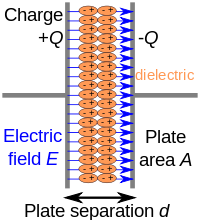
Photo from wikipedia
The dependence of AC conductivity and dielectric properties on the frequency and temperature for TlInSe2 in pellet form obtained from TlInSe2 single crystal were studied in the frequency range of… Click to show full abstract
The dependence of AC conductivity and dielectric properties on the frequency and temperature for TlInSe2 in pellet form obtained from TlInSe2 single crystal were studied in the frequency range of 42 Hz–5 MHz and temperature range of 294–393 K. The structure of TlInSe2 in powder form was examined using X-ray diffraction. TlInSe2 at room temperature was found to be tetragonal system with lattice parameters of a = 8.063 Å and c = 6.827 Å. The structural parameters, such as crystallite size D, micro strain ε, dislocation density δ, and unit cell parameters were determined from XRD spectra. The AC conductivity of the TlInSe2 was found to obey the power law, i.e. $${\sigma }_{ac}\left(\omega \right)= A{\omega }^{s}$$σacω=Aωs. AC conductivity of TlInSe2 was dominated by the correlated barrier hopping (CBH) model. The obtained activation energy values of the AC conductivity have confirmed that the hopping conduction is the dominant one. Where, a decrease in these values has noticed with the increase in frequency. The density of localized states $$N\left({E}_{F}\right)$$NEF close to Fermi level for TlInSe2 was obtained in the range of 1.02–2.8 × 1019 eV−1 cm−3 for various temperatures and frequency. The frequencies corresponding to maxima of the imaginary electric modulus at different temperatures were found to satisfy an Arrhenius law with activation energy ER of 0.32 eV. A decrease in the relaxation time τ was observed with the increase in temperature. The average hopping distance R and the average time of charge carrier hoping between localized states t were found in the range of 6.10–11.95 nm and 2 × 10−7–2.4 × 10−2 s respectively, for the investigated range of frequency and the value of the binding energy Wm was 0.52 eV. The dielectric relaxation mechanism was also explained by the Cole–Cole types.
Journal Title: Journal of Materials Science: Materials in Electronics
Year Published: 2018
Link to full text (if available)
Share on Social Media: Sign Up to like & get
recommendations!